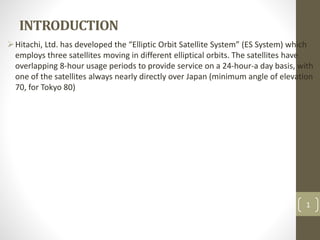
HEO(Highly elliptical orbit) satellites.pptx
- 1. INTRODUCTION Hitachi, Ltd. has developed the “Elliptic Orbit Satellite System” (ES System) which employs three satellites moving in different elliptical orbits. The satellites have overlapping 8-hour usage periods to provide service on a 24-hour-a day basis, with one of the satellites always nearly directly over Japan (minimum angle of elevation 70, for Tokyo 80) 1
- 2. 2 How useful are elliptical orbits for communication? How are they used? Early low-orbiting satellites were launched into Highly Elliptical Orbits (HEO) as a result of not having much control over trajectory. Circular orbits with minimal eccentricity offer consistent altitudes,with the benefits of consistent free space losses and link budgets throughout the orbit, and soon became the norm. Highly elliptical orbits fell from favour for communications use. Most communication through orbiting satellites is now via the circular geostationary ring,at 35,786 km above the Earth’s equator. There, the angular velocity of the satellites’ motion matches the eastward rotation of the Earth’s surface. The result is that the satellites appear to be approximately fixed in the sky, modulo minor perturbations.
- 3. 3 Satellite dish reflectors can be fixed in position on the ground to point at each satellite in its allocated orbital slot. Satellites in this orbit have a wide view of the Earth, seeing a belt between approximately 75° of latitude North and South. At higher latitudes, the geostationary ring lies below the local horizon, and these satellites are out of view. THEORETICAL ELLIPTICAL ORBITS Highly elliptical orbits have been explored, designed, and promoted extensively by John E.Draim and colleagues .
- 4. HEO(Highly elliptical orbit) satellites Highly elliptical orbit (HEO):This class comprises all satellites with noncircular orbits. Currently,only a few commercial communication systems using satellites with elliptical orbits are used These systems have their perigee over large cities to improve communication quality 4
- 5. Principalfeaturesare as follows Due to the satellites’ high angle of elevation,screening interference from mountains and skyscrapers is minimized. Signals can be received directly from satellites; thus as a general rule uniform nationwide service can be provided without the use of ground repeaters. Signals can be directly transmitted from terminal to satellite; thus bi- directional communication networks can be easily constructed. 5
- 6. Pure radio wave propagation routes are used,minimizing multiple reflection waves and enabling signal intensity fluctuation to be greatly reduced. Reception antenna beam can be restricted to the upper-sky direction; thus antenna gain can be increase 6
- 7. 7
- 8. conclusion A review of planned uses of elliptical orbits has found a previous proposal that complements the orbital geometry of a broadband satellite system currently under construction. Adding satellites in elliptical orbits to O3b can be technically feasible with considerable reuse of existing technology. There may be demand and a business case for broadband Internet services to remote high-latitude locations that can best be served by satellite, and O3bNetworks’ equipment could be adapted to meet that demand. 8
- 9. However, the history of satellite telephony and broadband constellations shows that what is considered technically feasible is not necessarily what best meets the needs of operating companies or of potential users. Imagination, innovation and actual implementation are often very different things. Elliptical orbits may not gain widespread use for communication, remaining a small niche in the communications niche that is satellite communication 9
- 10. References 10 1.Google.com/elliptical.pdf 2.Revisiting elliptical satellite orbits to enhance the O3b constellation